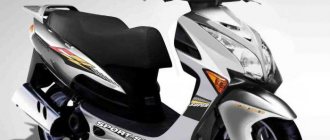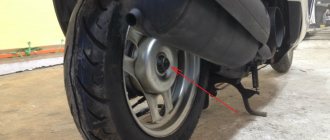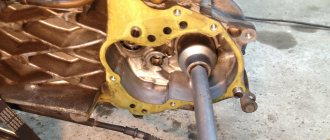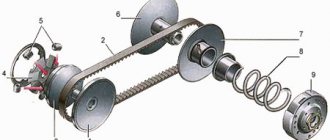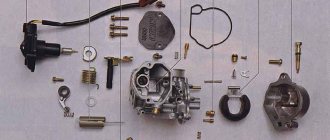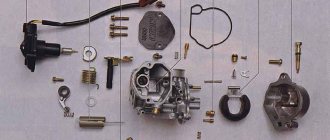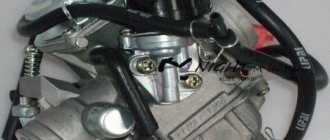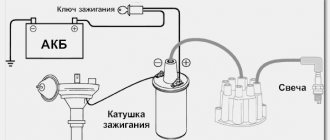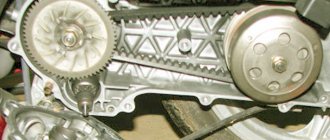Tire guide. Maxi scooter
The trend in recent years is adapting tread patterns and using technologies from motorcycle tires for maxi-scooters. And this is right - “self-running sofas” have now brought the power, weight and maximum speed indicators close to those of medium-sized motorcycles.
Unfortunately, Asian players are not strong in this market; Europeans rule the roost here. And in the concept of “Asian” I mean not only traditional countries producing inexpensive goods such as China, Thailand, Taiwan, but also Korea and Japan will also be on the list. Unfortunately, neither Bridg e stone nor Dunlop created masterpieces, developing tires for maxi-scooters clearly on a residual basis. Even the Dunlop Scootsmart, which has absorbed the developments of the successful Roadsmart-2 motorcycle sports and touring tires, does not have grip on wet asphalt and is more suitable for the warm Asian summer than for the cold European autumn.
But the Europeans have something to offer, even with variations. We did not divide the table into price categories, because in scooter tires the price depends not on the tread pattern, but on the design of the wheel. Diagonal tires are usually cheaper than radial tires, and the price can differ by half, especially if they have different speed indexes. And the design of the tire is affected by its size. The lower the profile (the second digit in the size, written with a fraction), the more likely it is that the tire will be a radial. To illustrate, look at the price difference between the very similar 160/60-14 and 150/70-14 sizes (complete with the same 120/70-15 front) - very clear.
“Winter” tires for scooters stand apart. According to the legislation of many European countries, it is forbidden to ride a motorcycle-scooter on the road in winter with “summer” tires, so “winter” wheels are produced with the M + S (mud + snow) marking. You just need to understand that the European winter is like our April: temperatures are slightly above zero, rain, sometimes snow flakes, but the roads are always cleared. You shouldn’t demand grip properties from them on ice at –10 °C. It’s just that the composition of the rubber mixture has increased the content of silicon dioxide, which helps maintain elasticity in the near-zero temperature zone, and increased the number of drainage grooves, which help improve grip on wet asphalt. For Metzeler it will be Feelfree Wintec, for Michelin it will be City Grip Winter. It is good to open and close the season on such tires, but in the summer and temperatures above +20 ° C it is better to change them to regular “summer” versions. They will also be relevant in mountainous areas, where it is warm below, and there may be snow on the passes. But remember that “winter” tires get very hot at high temperatures, begin to hold up worse and wear out faster.
Unlike motorcycle tires in the “A” segment, scooter tires are rarely made at headquarters in Europe. Most likely, the country of production will be Brazil, Malaysia, Korea, Thailand, but the place of origin may also be Eastern European countries - Croatia and Slovenia.
The largest online store for motor tires is the official dealer of all brands presented in the table. The stores have specialists who will help you make the right choice based on your scooter model, budget, riding style and desired resource. Fresh tires are available at the best prices, there is free delivery to more than 80 cities in Russia and the CIS, a system of bonuses and gifts. Many retail outlets have a motorcycle tire service.
Scooter tires
Every time, before snow falls or melts, the owner of the equipment is faced with the question of how to choose tires for a scooter. Motorcycles and scooters have only two wheels, so special attention should be paid to the quality and condition of tires compared to a car. This article will tell you what to consider when choosing tires for a scooter. Most of this article is suitable for both motorcyclists and motorists, since the main characteristics of all tires are similar.
The first thing you should pay attention to is the seasonality of tires. All tires are divided into summer, winter and all-season. In principle, there is no special wisdom here - the names speak for themselves. You simply cannot use out-of-season tires on a motorcycle or scooter. Summer tires become hard in cold weather, while winter tires in warm weather are too soft and wear out quickly. Although all-season tires for scooters seem practical, it is better to avoid using them. Average indicators will not give good grip on the road surface either in winter or in summer.
Tires can be tubed or tubeless. Here, too, no special explanation is required. It is believed that in the event of damage, a tubeless tire can be fitted with a tube, but this cannot always be done. The tire for installing the camera in it must have a special internal tread for good adhesion to the camera. If there is no such tread on the tube, then the tire will quickly wear out. Well, tubeless tires should only be used with wheels specially designed for such tires. Otherwise, the wheel may randomly disassemble while driving, which can lead to tragic consequences.
By design, tires are divided into radial (RADIAL-TYPE), diagonal (BIAS-TYPE) and mixed, having an additional stiffness belt (BIAS-BELTED). The latter are used only for motorcycles and special equipment. The cords in radial tires are located along the radius of the wheel and do not intersect. They are stiffer, less susceptible to deformation at high speeds and have a more stable contact patch with the road surface. Also, radial scooter tires have lower rolling resistance and reduce fuel consumption. Radial tires are commonly used on motocross and sports motorcycles and scooters. In bias-ply tires, the cords intersect in pairs. They are easier to produce and, as a result, cheaper. It is rational to use such tires on off-road and roads with potholes, because... they are better at reducing shock loads. At the moment, radial tires for scooters and motorcycles have practically replaced diagonal tires.
When choosing a tire for a scooter or motorcycle, the tread pattern plays an important role. Basically, if we do not consider various subtleties, we can say that the tread pattern is designed in such a way as to remove water from the surface of the tire at the moment of contact with the road surface. A larger number of tread grooves performs this role better. Therefore, if you are the owner of a touring or cruiser motorcycle and travel frequently, take care of a sufficient number of grooves. For sports motorcycles or for riding only on dry pavement, tires with fewer grooves are better suited to increase the total area of contact between the tire and the road, which will improve the tire's grip on the surface of the pavement.
In conclusion, we will consider the main symbols and markings used on tires. The figure shows the location of the designation elements used on tires. Depending on the manufacturer, the arrangement of the elements may vary slightly. Let's look at some notations in more detail. The tire model indicates the conditions in which the tire can be used. Each manufacturer has its own model names, so there is no point in indicating them. More information about the models of each manufacturer can be found on the corresponding websites. Often the name provides more information for selection depending on operating conditions than standard designations. Therefore, if you are a fan of a particular brand, check out the features of the models on the manufacturer’s website before purchasing.
The next important characteristic is tire size. The first number indicates the width of the tire in millimeters, the second (through a fraction) the profile height as a percentage of the width. The tire width must match the rim size. Next, the marking indicates the tire design: “R” - radial (and not radius, as many people think); “–” — diagonal; “B” - diagonal with an additional stiffening belt. The next number in the marking is the rim diameter. Explanation of the last two indicators: load index (at maximum internal pressure) and speed index are indicated in the tables below. Failure to comply with these indicators can result in rapid wear and even deformation or rupture of the tire.
Tire Speed Index Table
| Speed index | Max speed, km/h | Speed index | Max speed, km/h | Speed index | Max speed, km/h |
| A | 40 | L | 120 | H | 210 |
| B | 50 | M | 130 | V | 240 |
| C | 60 | N | 140 | W | 270 |
| D | 65 | P | 150 | Y | 300 |
| E | 70 | Q | 160 | WR | >210 |
| F | 80 | R | 170 | ZR | >240 |
| G | 90 | S | 180 | (W) | >270 |
| J | 100 | T | 190 | Z | >300 |
| K | 110 | U | 200 |
Tire load index table
| Load Index | Max weight, kg | Load Index | Max weight, kg | Load Index | Max weight, kg |
| 1 | 46,2 | 21 | 82,5 | 41 | 145 |
| 2 | 47,5 | 22 | 85 | 42 | 150 |
| 3 | 48,7 | 23 | 87,5 | 43 | 155 |
| 4 | 50 | 24 | 90 | 44 | 160 |
| 5 | 51,5 | 25 | 92,5 | 45 | 165 |
| 6 | 53 | 26 | 95 | 46 | 170 |
| 7 | 54,5 | 27 | 97,5 | 47 | 175 |
| 8 | 56 | 28 | 100 | 48 | 180 |
| 9 | 58 | 29 | 103 | 49 | 185 |
| 10 | 60 | 30 | 106 | 50 | 190 |
| 11 | 61,5 | 31 | 109 | 51 | 195 |
| 12 | 63 | 32 | 112 | 52 | 200 |
| 13 | 65 | 33 | 115 | 53 | 206 |
| 14 | 67 | 34 | 118 | 54 | 212 |
| 15 | 69 | 35 | 121 | 55 | 218 |
| 16 | 71 | 36 | 125 | 56 | 224 |
| 17 | 73 | 37 | 128 | 57 | 230 |
| 18 | 75 | 38 | 132 | 58 | 236 |
| 19 | 77,5 | 39 | 136 | 59 | 243 |
| 20 | 80 | 40 | 140 | 60 | 250 |
The letter “F” or the words “Front Wheel” or “Front Wheel Only” after the size means that the tire is intended for installation on the front wheel only. The inscription “Rear Wheel” means that the tire can only be installed on the rear wheel.
The word "Rotation" with an arrow or just an arrow indicates the direction of rotation. If the arrow is missing, then the tire can be installed as desired.
"TT" or "Tube Type" means the tire is intended for use with a tube only. The words “TL” or “Tubeless” indicate tubeless tires. The tightness of such tires is ensured by a layer of special rubber on the inner ring, and the special design of the rim allows such tires to be securely fixed. If you are going to use tubeless tires, make sure your rims are designed to handle tubeless tires.
The maximum permissible air pressure in a tire is specified in kilopascals (kpa) and pounds per square inch (pci). The maximum load is indicated in kilograms (KG) or pounds (LBS).
Other bus parameters indicated in the figure are intuitive; there is no point in describing them here. The designations of various conformity marks have similar parameters; if you are interested, information can be found on the Internet.
Summer or winter
Seasonality in motorcycle tires can be seen just as clearly as in car tires. And, along with the division into winter and summer, there are also all-season options. They differ in their ability to resist slipping, which becomes of primary importance for a scooter rider.
Out-of-season tires add to the dangers on the roads, as the composition of winter tires softens in the heat and quickly wears out on hot asphalt. And summer ones become stiff from the cold and lose the necessary elasticity. Opinions about the all-season vehicle completely agree with the statements of car enthusiasts.
Such tires are economical and practical only in appearance . In reality, average indicators are simply not able to provide maximum reliability of traction on either icy or dry road surfaces. With common sense, it is better not to save in this way.
Types of Motorcycle Tires
A particularly dangerous type of transport, a motorcycle is a rather complex system. Therefore, it is so important that all its parts and mechanisms work very reliably. And motorcycle tires are considered one of the most important elements of this vehicle.
Motorcycle tires are divided into two types and differ significantly from each other:
Diagonal tires
Radial tires
Tire developers face very complex and sometimes contradictory challenges in their work. First, motorcycle tires should not slip. The engine power must be transferred to these tires quite efficiently. Secondly, tires should wear out at a minimum speed and evenly. Tires are selected for the specific conditions of their use. And when choosing them, you need to sacrifice something.
Explanation of motorcycle tire markings
Explanation of motorcycle tire markings Figure 2
Tire manufacturers have calculated everything and are offering us ready-made solutions for each specific case.
How to choose the right tires for your motorcycle
Now you know approximately what types of tires are produced. What else is important when choosing tires? Of course, their quality. Motor rubber is a very important part of motorcycles, so it must be abrasion-resistant and the most wear-resistant. Tires can be soft or hard. Soft ones grip the road well. Hard – wear-resistant. But all manufacturers are trying to ensure that these qualities are combined in all their tires.
Many motorcyclists prefer wide models. This choice may not always be correct. Here you need to take into account the distance that is between the wings and suspensions. An increased tire size will worsen the handling of motor vehicles. And it will be unsafe to drive on such tires.
To increase wear life, pay special attention to tire inflation. Low tire pressure will cause tire wear to occur very quickly. And of course, the service life of any tires also depends on your driving style.
Table 1. Explanation of the load index.
| Load Index = Speed Limit | |
| Letter | KM. |
| J | 100 |
| K | 110 |
| L | 120 |
| M | 130 |
| N | 140 |
| P | 150 |
| Q | 160 |
| R | 170 |
| S | 180 |
| T | 190 |
| U | 200 |
| H | 210 |
| V220 | 220 |
| V230 | 230 |
| V or V240 | 240 |
| V250 | 250 |
| V260 | 260 |
| W or V270 | 270 |
| V280 | 280 |
| V290 | 290 |
| Y or V300 | 300 |
| Z | more than 240 |
Motorcycle tire size
Table 2. Dimensions for all motorcycle tire marking systems.
| Acceptable value, rim width | Metric | Alpha | Standard in inches | Low profile in inches |
| 1.60, 1.85 | 70 | MG | 2.75 | – |
| 1.60, 1.85 | 80 | M.H. | 3.00 | 3.60 |
| 1.85, 2.15 | 90 | MJ | 3.25 | 3.60 |
| 1.85, 2.15 | 90 | M.L. | 3.50 | 4.10 |
| 2.15, 2.50 | 100 | MM | 3.75 | 4.10 |
| 2.15, 2.50, 2.75 | 110 | MN | 4.00 | 4.60 |
| 2.15, 2.50, 2.75 | 110 | MP | 4.25 | 4.25/85 |
| 2.15, 2.50, 2.75 | 120 | M.R. | 4.50 | 4.25/85 |
| 2.15, 2.50, 2.75 | 120 | MS | 4.75 | 5.10 |
| 2.50, 2.75, 3.00 | 130 | M.T. | 5.00 | 5.10 |
| 2.75, 3.00, 3.50 | 140 | M.U. | 5.50 | – |
| 3.50, 4.00 | 150 | MV | 6.00 | – |
| 4.00, 4.50 | 160 | – | 6.25 | – |
Tire size
It is better to choose the tire size specified by the manufacturer. However, some models allow you to install larger tires, and this can sometimes be very useful.
The rear wheel of the scooter takes on the main load while moving. Accordingly, the larger the contact patch with the road, the higher the stability of the scooter, but this is one of many indicators that must still be met. Naturally, if the model of your scooter allows you to install a rear tire wider than the nominal one, this is worth doing. You need to prepare for the fact that after such a replacement, gasoline consumption will increase slightly and dynamics will decrease, because the resistance to the road surface has increased.
Motorcycle tire pressure
If you bought a motorcycle from a dealership, it will definitely describe the recommended pressure for both wheels. Focusing only on these numbers is not advisable. The tires on the motorcycle you are using should be set to the maximum appropriate pressure. And this depends on the model of the motorcycle, the brand of tires, the weight of the luggage and the motorcyclist himself along with the passenger, and the conditions of the trip.
You need to start from the recommended pressure for the tire model you choose. The developers take into account all the features of rubber and its technology. We can use a motorcycle for a different purpose each time. This could be just a walk along an asphalt road, long journeys to another city, or performing all sorts of tricks on a go-kart track. How to correct pressure in such cases? For long trips on road tires, you can use the manufacturer's recommended pressure. To walk around the city, you need to keep the pressure in both wheels approximately the same. On karting tracks, it is best to slightly reduce the pressure in both tires.
Go by the numbers recommended by the manufacturer, but don’t be afraid to experiment with pressure, only within reason. You need to understand how your motorcycle will perform in different situations. But caution should always come first.
When choosing tires for your motorcycle, pay attention to Dunlop tires. It has been in demand by motorcyclists since the nineteenth century. This is due to its quality and large selection of varieties.
Motorcycle tire pressure
What pressure should be in motorcycle tires?
In addition to the level of tire inflation, it is important to pay attention to other characteristics of the wheels.
Source
Scooter wheels - type, advantages and disadvantages
When we talk about wheels on a scooter, we talk about both rims and tires.
This also includes the size, material of the discs and its type. Today in the scooter market there is a more or less standard situation with the design of wheels: these are cast, stamped or spoked wheels with tires made of rubber of various densities. Alloy wheels are the most common and use light alloy materials, usually aluminum, as the main material.
Cast alloy scooter wheel
Such discs are installed on Chinese and European scooters of the middle and high price range, as well as on Japanese models of the high price range.
Stamped steel scooter disc
Used Japanese scooters, as well as Chinese budget models, are often equipped with stamped steel wheels. They are less resistant to corrosion, less durable and more likely to bend, but they are also easy to level, unlike their cast counterparts.
Spoke wheels are commonly found on large wheel scooters, scooterettes and mopeds. On the same mopeds, for example Viper Delta and its clones, alloy wheels are becoming very popular, but if they are deformed, correcting the runout will be problematic. With spokes, it’s much easier here; everyone remembers how they corrected the “eight” on bicycles.
The front and rear wheels are usually different. The front wheel consists of a shaft, a machine with gears for measuring the speed of movement (the speedometer cable fits here), and a mount for a disc brake. Japanese scooters in the budget segment still have a drum brake installed at the front. The rear wheel on Chinese and Japanese scooters is usually equipped with a drum brake; Europeans have recently switched to disc brakes.
Cast scooter disc made of light alloy materials for tubeless tires
Advantages of alloy wheels on a scooter:
Alloy Wheel for Chinese Scooter
Disadvantages of alloy wheels:
Advantages of stamped wheels on a scooter:
Disadvantages of stamped discs:
Advantages of spoked wheels on mopeds and scooters:
Moped with spoked wheels
Scooter tires 130 60 R13
This size is most often found in scooters. It is suitable for moderately cold regions, icy and snowy roads. Typically, this size is made with Velcro, not spikes.
Characteristic of such rubber are deep longitudinal grooves with a system of outlet channels. It is better not to use spikes with this standard size, because... they will produce noticeable vibrations, which will lead to poor control.
Characteristics of tires for scooter 120 70 12
The standard size of winter tires for scooters 120 70 12 is no less common, both on domestic and foreign scooters. It is well suited for country roads, but less effective on city roads.
It has good cross-country ability if you prefer to ride a scooter through the forest or grove. The size is perfect for deep snowdrifts, but copes worse with loose snow. As in the case of the previous standard size, Velcro rubber is predominantly found here, rather than studded.
